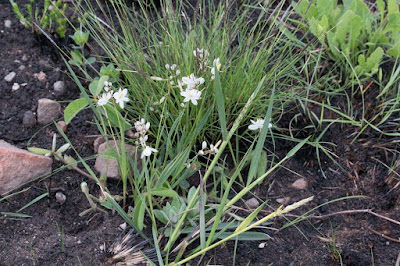The original post on this walk somehow was overwritten by the contents of another post, and this is my best effort to reconstruct the post.
We decided it was time to revisit the Ngonyama Gorge and a small group of us braved the Stop/Go signs on the R61 on our way there. After one or two missed turns we arrived at a rural dwelling where we arranged to park.
 |
| Arranging parking |
We set off towards what we thought might be a more accessible decent into the Ngonyama gorge, stopping along the way to look at the trees in one of the watercourses. Here we saw Diospyros villosus in fruit and Flagellaria guineensis in flower.
 |
| Diospyros villosus fruits |
 |
| Flagellaria guineensis flower |
From here we ascended to a plateau where we saw Gladiolus wilsonii and Indigofera rubroglandulosa and numbers of Clutia disceptata in flower. Phakamani found a Eulophia hians and then we came across a low mound which had a number of shrubs growing on it. Amongst these were a Ehretia rigida in flower, an a Sideroxylon inerme in fruit.
 |
| Clutia disceptata |
 |
| Ehretia rigida |
We walked further to a low scarp where we found Haemanthus albiflos and Mimusops obovata flowers. Nestling in the grass at the base of one of these shrubs were a number of Bonatea boltonii.
 |
| Haemanthus albiflos |
 |
| Mimusops obovata |
 |
| Bonatea boltonii |
At the bottom of this low scarp we saw bright red seeds of a Stangeria eriopus and while we were looking at this Gail found an interesting orchid - clearly a Disperis but not one we knew. After consulting references later we determined that this was Disperis woodii - a great find as there are not many locations known for this species.
 |
| Stangeria eriopus fruits |
 |
| Disperis woodii |
We worked our way around towards the Ngonyama gorge and found a route down to near the waterfall - from here we had a good view of the waterfall and the gorge below but there did not seem to be an easy route down into the gorge. Chris clambered around some rocks and found a cave with a view down into the Mzamba River gorge.
 |
| Ngonyama falls |
 |
| Chris in his man-cave |
We decided that it would be easier to take a path we had seen earlier and follow this down into the Mzamba gorge and possibly make our way up the Ngonyama river from there. On the way down the steep path through the forest we came across a Manilkara nicholsonii. We eventually reached the river finding numbers of Cyrtanthus mackennii amongst the coarse riverside-grass. Here we also saw Gymnosporia bachmannii, Lugwigia octovalvis and Syzygium pondoensis.
 |
| Cyrtanthus mackennii |
 |
| Ludwigia octovalvis |
The river looked too inviting so pretty soon everyone had shoes off and feet in the water while we had our lunch. Chris wandered off and soon returned, first with a Spiny agama and then later he managed to catch a Spiny agama and a little later he returned with a rather smelly Cape terrapin in his hands.
 |
| Lunch time at the Mzamba river. |
 |
| Mzamba river |
 |
| Spiny agama |
 |
| Cape terrapin |
Watch what happened when he released the terrapin.
After botanising for a while along the river banks we found an Eriosema psoraloides in fruit.
 |
| Eriosema psoraloides fruits |
We decided it was better to defer our attempt to walk up the Ngonyama gorge to another date so we set off back up the path to the top. Once at the top we worked our way along the steep drop-off down into the Ngonyama. Here we were luck to find the unobtrusive Brachystelma pygmaeum in flower.
 |
| Catching our breath after emerging from the gorge |
 |
| Brachystelma pygmaeum |
Our walk back to the vehicle gave us these views of a herdsman returning home with his cattle.
 |
| Homeward bound cattle and herdsman (photo Gail B-W) |
 |
| Homeward bound walkers (photo Gail B-W) |
Participants: Anne S, Gail B-W, Graham G, Kate G, Phakamani M.













































































































